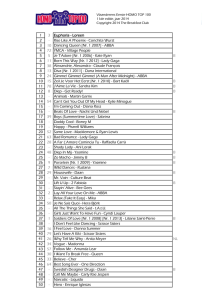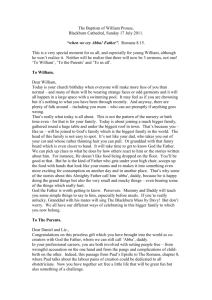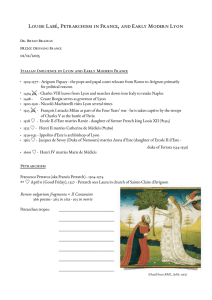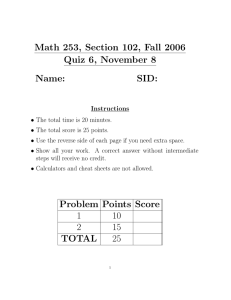M Messianic Claims and Institutionalization 1
advertisement
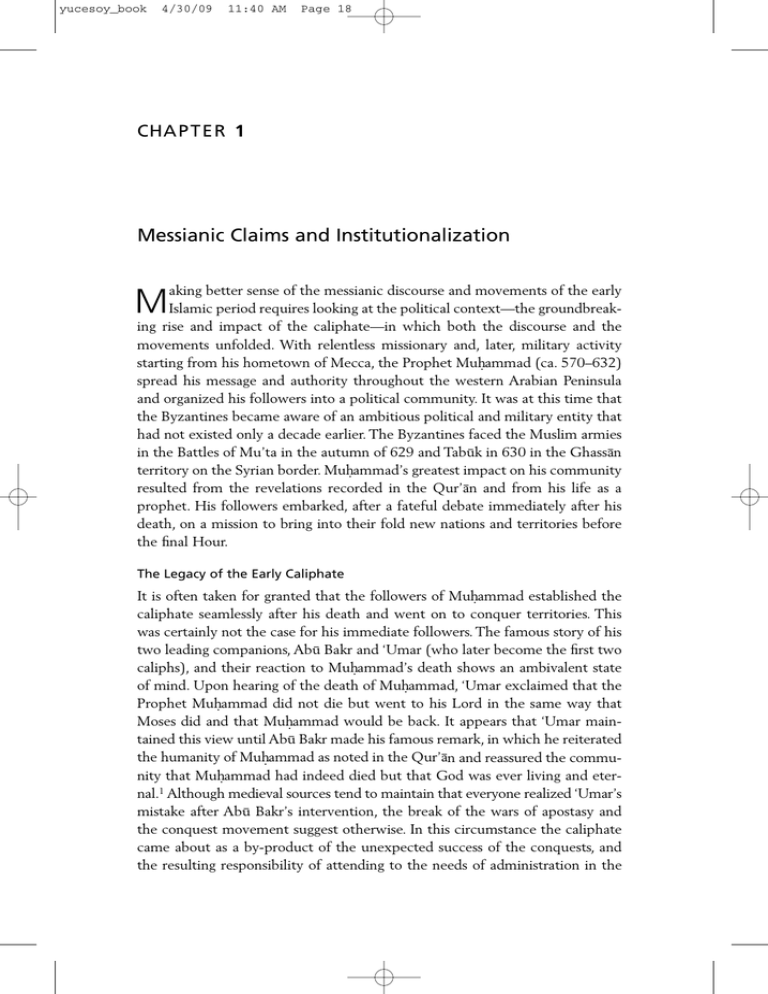
yucesoy_book 4/30/09 11:40 AM Page 18 CHA P T E R 1 Messianic Claims and Institutionalization aking better sense of the messianic discourse and movements of the early Islamic period requires looking at the political context—the groundbreaking rise and impact of the caliphate—in which both the discourse and the movements unfolded. With relentless missionary and, later, military activity starting from his hometown of Mecca, the Prophet Muh.ammad (ca. 570–632) spread his message and authority throughout the western Arabian Peninsula and organized his followers into a political community. It was at this time that the Byzantines became aware of an ambitious political and military entity that had not existed only a decade earlier. The Byzantines faced the Muslim armies in the Battles of Mu’ta in the autumn of 629 and Tabu–k in 630 in the Ghassa–n territory on the Syrian border. Muh.ammad’s greatest impact on his community resulted from the revelations recorded in the Qur’a–n and from his life as a prophet. His followers embarked, after a fateful debate immediately after his death, on a mission to bring into their fold new nations and territories before the final Hour. M The Legacy of the Early Caliphate It is often taken for granted that the followers of Muh.ammad established the caliphate seamlessly after his death and went on to conquer territories. This was certainly not the case for his immediate followers. The famous story of his two leading companions, Abu– Bakr and ‘Umar (who later become the first two caliphs), and their reaction to Muh.ammad’s death shows an ambivalent state of mind. Upon hearing of the death of Muh.ammad, ‘Umar exclaimed that the Prophet Muh.ammad did not die but went to his Lord in the same way that Moses did and that Muh.ammad would be back. It appears that ‘Umar maintained this view until Abu– Bakr made his famous remark, in which he reiterated the humanity of Muh.ammad as noted in the Qur’a–n and reassured the community that Muh.ammad had indeed died but that God was ever living and eternal.1 Although medieval sources tend to maintain that everyone realized ‘Umar’s mistake after Abu– Bakr’s intervention, the break of the wars of apostasy and the conquest movement suggest otherwise. In this circumstance the caliphate came about as a by-product of the unexpected success of the conquests, and the resulting responsibility of attending to the needs of administration in the yucesoy_book 4/30/09 11:40 AM Page 19 Messianic Claims and Institutionalization 19 short and long term required predictability in governance. Yet anxieties continued to clash with institutionalization. It is within this context the politics of early Islamic history unfolded. Four major civil wars shook the caliphate in the first two hundred years of its existence. Two of the civil wars led to drastic dynastic changes (from the Patriarchal Caliphate to the Umayyads in 661 and from the Umayyads to the ‘Abba–sids in 750), and the other two overwhelmed the center of political power and the provinces for more than a decade each. In each of these civil wars, messianic and apocalyptic expectations played a large role. After a chain of disturbances in the provinces and with the assassination of the third caliph, ‘Uthma–n b. ‘Affa–n, in 656, the door was opened for the first civil war (called, reproachfully, fitna). This conflict eventually led to the demise of the Patriarchal Caliphate and the rise of Umayyad rule. Several prophecies pointed to the coming of the final day in the year 35/656, projecting the first civil war as a truly apocalyptic battle.2 As a result of these conflicts, the sectarian diversification of the Muslim community also began. The relatively homogeneous community of the Prophet Muh.ammad, at least in terms of dogma, broke into diverse subgroups and classes. The golden era of unity, as it would be remembered and invoked in sociopolitical struggles of later times, was gone. From the first to the third civil war, the Muslim community witnessed the emergence of the Kha–rijı– sect and the galvanization and eventual mobilization of the supporters of the family of ‘Alı– around a Shı–‘ı– cause. Both of these movements sheltered extremist subsects whose influence on the social and political life in Islamic history can hardly be overestimated. By the time of the ‘Abba–sid revolt in the middle of the eighth century, both sects had been firmly established in religio-political life. These were the most visible sects, but a myriad of other groups also appeared, defining and redefining themselves in relation to other sectarian movements, the caliphate, and increasingly non-Muslim cultural and religious influences. In the context of confessional and sectarian disputes and of political rivalry in the first Islamic century, the initial use of the concept of the Mahdı– appeared. It seems that perhaps during the first civil war, ‘Uthma–n and ‘Alı–, and shortly – afterward the latter’s younger son, al-H . usayn, were venerated as Mahdıs by their supporters, who coined probably one of the most enduring epithets in Islamic history.3 The use of the title Mahdı– soon proliferated. How religiopolitical factions decided to articulate their claims using messianic vocabulary and attribute to their messianic figures eschatological qualities (for example, concealment, the idea of return) can best be studied within the political and sociocultural context of the first Islamic century. It is quite possible that the title initially meant a rightly guided caliph who would restore Islam to its original perfection, as Madelung suggested, gradually picking up an eschatological dimension.4 However, the sudden proliferation of the title with eschatological aspects (as early as the movement of al-Mukhta–r, for instance) and its clear yucesoy_book 4/30/09 11:40 AM Page 20 20 Messianic Beliefs and Imperial Politics redemptive meaning during middle Umayyad times suggest otherwise. Yet if it is assumed that the figure of the messiah was in place from the beginning, how can its absence from the Qur’a–n be explained?5 The title seems to have increasingly acquired a redemptive nuance in a short period of time, as the end-of-time prophecies coincided with its use. Though an investigation into the origins of the title Mahdı– is outside the scope of this book, suffice it to say that in the turbulent period after the death of the Umayyad caliph Yazı–d I (r. 680–83), Umayyad opposition did use messianic concepts to articulate their claims. The Shı–‘ı– al-Mukhta–r, the Meccan Ibn al-Zubayr, and even the Umayyad caliphs themselves expressed their claims and ambitions using messianic vocabulary. In the movement of al-Mukhta–r, the title Mahdı– became associated with an eschatological redeemer.6 If previous proto-Shı–‘ı– movements had inspired al-Mukhta–r’s followers to use the title – Mahdı–, in the H . ijaz region Ibn al-Zubayr promoted the legacy of the Patriarchal Caliphate in Medina against the Umayyads and used messianic language to articulate his claims, perhaps shaping the image of messiah for the following generations.7 Provoked by the heated confrontation between the Umayyad troops and the forces of Ibn al-Zubayr, a number of curious predictions anticipated the end of time in and around 70/689–90.8 The use of the title Mahdı– by a diverse group of people shows that it was not perceived to be the prerogative of any single individual, family, or tribe. Even groups or individuals outside the Quraysh tribe developed messianic aspirations of their own, perhaps motivated by tribal competition, which made the claims to messianic status widely accessible. The emergence and spread of prophecies regarding the coming of a south Arabian deliverer, the Qah.t.a–nı–, demonstrate not only the flexibility of messianic ideas to accommodate a range of aspirations but also their currency during Umayyad times.9 One such prophecy makes the coming of the south Arabian deliverer a portent of the end of time: “The Hour will not come until a man from Qah.t.a–n will come forth leading the people with his staff.”10 Apparently prophecies of this sort encouraged Ibn al-Ash‘ath, whose uprising against the Umayyads garnered the support of a large number of jurists, to identify himself with the titles of al-Mans.u–r and al-Qah.t.a–nı– during his revolt in 80/699.11 In the final decade of the Umayyad – – caliphate, al-H . arith b. Surayj also claimed the title of al-Mans.ur for himself in his uprising against the Umayyad governor Nas.r b. Sayya–r. It appears reasonable to conclude that since the end of the first Islamic century, the idea of Mahdı– (or an analogous figure) was both widespread and politically meaningful. It is no surprise, then, that the Umayyad caliphs also relied on prophecies to back their own political claims. The title Mahdı– often connoted the rule of justice under the caliph as a title of respect, but not always. With regard to Sulayma–n b. ‘Abd al-Malik and ‘Umar II, it referred to their redemptive and eschatological roles.12 Some prophecies depicted even the Umayyad court and yucesoy_book 4/30/09 11:40 AM Page 21 Messianic Claims and Institutionalization 21 the city of Damascus as refuges for those running away from apocalyptic battles or as gathering points for people of goodwill and saintly vicars, aba–dila.13 The prime example of Umayyad messianic aspirations is the legend of the Sufya–nı–. The legend seems to have appeared on the historical scene only after the demise of the Sufya–nı– branch of the Umayyad family in the second civil war. While its initial use as an Umayyad savior and the Shı–‘ı– use of it as an anathema still require further investigation,14 it seems that the Sufya–nı– prophecies already circulated during Umayyad times, although they proliferated after the establishment of the ‘Abba–sid caliphate.15 As early as the reign of the first ‘Abba–sid caliph, ‘Abdalla–h Abu– al-‘Abba–s al-Saffa–h. (r. 132–36/749–54), Abu– Muh.ammad Ziya–d b. ‘Abdalla–h, one of the grandsons of the second Umayyad caliph, Yazı–d b. Mu‘a–wiya, claimed the title of al-Sufya–nı– during his revolt against al-Saffa–h. as the expected savior who would return the caliphate and the fortune, or dawla, of the Umayyads to the Sufya–nids.16 The claims of the Umayyads were kept in check by the counterclaims of the opposition.17 The decades leading to the ‘Abba–sid revolution in 132/750 unleashed a rich array of messianic movements, including that of the ‘Abba–sids, which was born of a Shı–‘ı– religio-political sect, the Kaysa–niyya, whose members were fervent with messianic ideas. The messianic claims of the ‘Abba–sids contrast starkly with the pessimistic tone of Umayyad and anti-‘Abba–sid prophecies. As the revolt raged in Khura–sa–n, prophecies for the cause of the ‘Abba–sids foretold the collapse of the Umayyads and the dawn of a new era of justice.18 Although the majority of the prophecies concerning the black banners and the ‘Abba–sids date back to the final decade of the Umayyad caliphate, ‘Abba–sid historiographical memory would like to date the movement to the end of the first Islamic century, the year 100 A.H. In fact, such a date might be plausible because the year 100 A.H. marked a unique moment of apocalyptic anxiety and messianic expectations in the early Islamic period.19 Prophecies about the Umayyad downfall are sufficiently numerous (even though the overwhelming majority of them come down to us in later sources) to suggest their widespread circulation among the Umayyads and their opposition.20 The disruption of social life and the resulting anxiety concerning the future instilled terror in the minds of many observers as prophecies predicted “excessive killing and speedy death and horrifying hunger” befalling the Bedouin Arabs (al-‘arab) after the year 125/743.21 Even the survival of the community up to the year 125/743 seemed uncertain in the circulating prophecies. Even if the community survived that date, there still would be apocalyptic battles, “all of which mentioned in the [prophecies of] the end of times.”22 Indeed the ongoing political and military strife often called to mind total annihilation around the year 125/743 and shortly afterward. Intra-Umayyad conflicts and the ascension of Marwa–n b. al-H . akam to the caliphal seat certainly gave the impression to many observers that after the year yucesoy_book 4/30/09 11:40 AM Page 22 22 Messianic Beliefs and Imperial Politics 129/747 the Umayyads were doomed. The emergence of the ‘Abba–sid revolutionary movement increased the troubles for the Umayyad dynasty. The ‘Abba–sid revolt cut across sectarian and confessional lines and was suffused with messianic expectations. A wealth of prophecies recorded the appearance of people with “strange garments” advancing from the East and the ransack of Damascus by the holders of black banners as a portent signaling the end of the world.23 The ‘Abba–sid revolutionary militia, decorated with black banners, seemed to have no mercy for the Umayyads: “The black banners will rise in 129/747 and the leader [Abu– Muslim?]24 will appear with a group of insignificant people, whose hearts are like [pieces of] iron, their hair reaching their shoulders; they have neither mercy nor compassion for their enemies.” The prophecy offers a detailed account of the rebels, yielding insight into the social origins of the revolutionary army: “They bear nicknames, and their tribes are villages. They wear garments like a dark night’s color, he [the Akbash] will lead them to the ‘Abba–sids, and that is their fortune.”25 Iranian-Zoroastrian apocalyptic prophecies in the eastern parts of the caliphate also seem to be informed by the emergence of the ‘Abba–sids, as Pa–zand speaks of “black banners and black garments.”26 Eventually the Umayyad caliphate collapsed under the weight of mounting problems of questionable legitimacy, tribal and provincial discontent, and pious opposition. Unable to cope with socioeconomic transformations that they themselves largely had shaped and the attendant political complications, and failing to establish political institutions around which they could rally popular support, the Umayyads vanished under the impact of a popular uprising. The remnants of the Umayyad family fled to North Africa and Spain to establish the celebrated Umayyad Emirate there. The ‘Abba–sid revolution of 750 in Khura–sa–n was born out of the growing sectarian, particularly Shı–‘ı–, opposition against the Umayyads and out of the social and political expectations of converts to Islam, who were called Mawa–lı–, clients, and were considered inferior to the Arab Muslims. Certainly the sociopolitical rift between the center of political power and the periphery, in particular the Iranian provinces, played a large role in the revolt. The revolt was organized by nobility belonging to the ‘Abba–sid family—the descendants of al‘Abba–s, the paternal uncle of Muh.ammad—and was structured so as to shore up as much support as possible from the ranks of the opposition to the Umayyads. The ‘Abba–sids operated from the town of H . umayma in today’s southern Jordan at the beginning of the second/eighth century, but the propaganda centered in Khura–sa–n, the region east of the Caspian Sea, with Marw as its hub. The armed rebellion toward the middle of the eighth century, the bulk of whose participants came from converts to Islam in Khura–sa–n, sealed the fate of the Umayyads. It also eliminated other contenders for the caliphate—most notably yucesoy_book 4/30/09 11:40 AM Page 23 Messianic Claims and Institutionalization 23 the ‘Alids, the descendants of the paternal cousin of the Prophet Muh.ammad and his son-in-law, the fourth caliph, ‘Alı–—from within the ranks of the revolt. The ‘Abba–sid revolution championed the family of the Prophet and called for an acceptable leader among his family, al-rid.a– min a–l Muh.ammad, the Ha–shimites. The Zoroastrian text Ja–ma–sp Namak clearly refers to the ‘Abba–sids as the descendents of Ha–shim: “Afterwards there come up T.a–jiks who bring up their seeds from the branch of Ha–shim.”27 The ‘Abba–sids made the black banners their symbol and kept black as their royal color even after they succeeded in overthrowing the Umayyads. Leaving aside the discussion of when exactly ‘Abba–sid political claims began28 and whether the color black as a symbol of rightful resistance originated in Khura–sa–n among the non-Arab supporters of the ‘Abba–sids, the use of black banners as a symbol of political resistance certainly proliferated in the later Umayyad period.29 The enthronement of the first caliph, al-Saffa–h., in 132/749 fulfilled prophecies that promised that the leadership would be transferred from one family to another and opened a new caliphal phase based in the small Iraqi town of Ha–shimiyya near the city of al-Ku–fa–, which was known as a center of Shı–‘ı– opposition. The capital eventually was moved to a new city near a small village known as Baghdad. Named the City of Peace, Madinat al-Sala–m, Baghdad was founded by the caliph al-Mans.u–r in 762 on the west bank of the Tigris River, leaving Damascus a discontented provincial town in the ‘Abba–sid era. It seems certain that the title al-Mahdı– was chosen to honor the first ‘Abba–sid caliph. He was addressed not only as al-Mahdı– but also as the Qa–’im, he who would rise.30 Other traditions making the Mahdı– a descendant of al-‘Abba–s (“the Mahdı– will be from the progeny of al-‘Abba–s”)31 and identifying him as ‘Abdalla–h date most probably from the later stages of the ‘Abba–sid revolt,32 even though a few accounts place such prophecies at earlier times.33 A piece of epigraphic evidence found on the walls of the al-Saffa–h. mosque in Yemen strongly supports the idea that he was presented as the Mahdı–.34 The messianic aspects of the ‘Abba–sid revolt were not a recently cultivated ideology. The ‘Abba–sids were intimately involved with the Kaysa–niyya sect and other extremist movements, ghula–t, especially in Iran. The origin of the ‘Abba–sid revolt is outside the purview of this book, but the manner in which the ‘Abba–sids became a part of various sectarian formations of the Kaysa–niyya sect and its subbranches merits a brief discussion. The Kaysa–niyya was both the cradle of the ‘Abba–sid claims and a powerful religio-political movement during the time of the Umayyads and the early ‘Abba–sids.35 During the Umayyad period, the Kaysa–niyya in its various branches constituted the bulk of the radical wing of the Shı–‘a. Although the movement appeared to be disintegrating after the middle of the second/eighth century,36 it left a permanent mark on the ‘Abba–sid identity. yucesoy_book 4/30/09 11:40 AM Page 24 24 Messianic Beliefs and Imperial Politics Since the movement of al-Mukhta–r, who claimed to have operated on behalf of Muh.ammad b. al-H . anafiyya (d. 81/701), the younger son of the fourth caliph, ‘Alı–, the opposition to the Umayyads, most particularly the ‘Alids and the ‘Abba–sids, harbored messianic beliefs. In fact al-Mukhta–r designated – Muh.ammad b. al-H . anafiyya the Mahdı.37 The supporters of Ibn al-H . anafiyya continued to believe that he was the Mahdı– even after the defeat of alMukhta–r. Some of his ardent supporters, who gave birth to the Kaysa–niyya movement, began to claim soon after his death that Ibn al-H . anafiyya was not dead but was in hiding and that they expected his return.38 A poem attributed to Kuthayyir ‘Azza, (d. 105/723) illustrates this belief: “Behold the imams from the Quraysh, possessors of the truth. . . . [Muh.ammad b. al-H . anafiyya] shall not taste death until he advances at the head of his cavalry with his banner before him. He has gone into concealment at Rad.wa, where he lives on honey and water.”39 After the death of Ibn al-H . anafiyya, his supporters split into several subsects, because they disagreed on the identity of the imam after him.40 Among the most prominent of such supporters was Ibn al-H . anafiyya’s son Abu– Ha–shim, who died childless (d. ca. 98/717–18). His party, known as the Ha–shimiyya,41 split into several groups after his death. One group claimed that Abu– Ha–shim was the Mahdı– and that he was alive, hiding in the mountains of Rad.wa. Another group maintained that the imamate had passed to the ‘Abba–sid Muh.ammad b. ‘Alı– b. ‘Abdalla–h b. al-‘Abba–s.42 According to the ‘Abba–sid historical memory, the ‘Abba–sid family held not only the imamate but also the knowledge of future events. For instance, the ‘Abba–sids maintained that Abu– Ha–shim gave Muh.ammad b. ‘Alı– the prophetic Yellow Script, al-s.ah.ı–fa al-s.afra–’, which foretold the rise of the black banners of Khura–sa–n. According to ‘Abba–sid apologetics, the script passed from one person to another through a prominent line of the Ha–shimites all the way from ‘Alı– to the founder of the ‘Abba–sid revolutionary movement, Muh.ammad b. ‘Alı–.43 Though the legend of the Yellow Script must be seen in light of the competition over legitimacy between the ‘Alids and the ‘Abba–sids, it nevertheless shows the occultist and messianic concerns of the dynasty.44 The followers of Baya–n b. Sam‘a–n (d. 119/736), known as the Baya–niyya, believed that Abu– Ha–shim would return as the Mahdı–.45 ‘Abdalla–h b. ‘Amr b. – H . arb, one of the Hashimiyya, claimed that the imamate had passed to him after Abu– Ha–shim. After Ibn H . arb died, he was believed to be still alive and 46 was expected to return. The Khida–shiyya were the followers of ‘Amma–r b. Yazı–d, nicknamed Khida–sh, who was an ‘Abba–sid propagandist active in the area of Nishapur and Marw.47 After Muh.ammad b. ‘Alı– and Khida–sh had a falling out over doctrinal differences, the supporters of Khida–sh announced that Muh.ammad b. ‘Alı– had given up the imamate and that it had passed to Khida–sh. After the execution of Khida–sh in 118/736, his supporters claimed that he was alive and had been raised to heaven by God.48 yucesoy_book 4/30/09 11:40 AM Page 25 Messianic Claims and Institutionalization 25 – Consisting mainly of the former H . arbiyya, the Janah.iyya sect supported the – – – 49 imamate of ‘Abdallah b. Mu‘awiya. ‘Abdallah b. Mu‘a–wiya is reported to have encouraged their extremist beliefs, claiming that the Divine Spirit had been transferred through the prophets and imams to him and that he was able to resurrect the dead. After he died in 131/748–49 in the prison of Abu– Muslim, who was a Khura–sa–nı– and the head of the ‘Abba–sid revolutionary army, a group of ‘Abdalla–h b. Mu‘a–wiya’s followers claimed that he was alive and hiding in the mountains of Is.faha–n.50 Some said that he would return as the Mahdı–, while others held that he would surrender the leadership to a descendant of ‘Alı– before his death.51 Abu– Muslimiyya was a subgroup of the Kaysa–niyya and maintained that the imamate had passed from the first ‘Abba–sid caliph, al-Saffa–h., to Abu– Muslim, whom the group considered its leader.52 After the execution of Abu– Muslim by the caliph al-Mans.u–r in 137/755, some of the supporters of Abu– Muslim maintained that the imamate had been transferred from al-Saffa–h. to Abu– Muslim and that Abu– Muslim was still alive.53 This group, called the (Abu–) Muslimiyya, believed that al-Mans.u–r had killed not Abu– Muslim but a person who only resembled him and that Abu– Muslim had gone into hiding. Opposed to them were the Riz.a–miyya, named after their chief, Riz.a–m b. Sa–biq, probably one of the Rawandı– extremists who upheld the succession of al-Mans.u–r to the imamate. Though they refused to repudiate Abu– Muslim, they affirmed that the imamate would remain in the ‘Abba–sid family until the resurrection, when a descendant of al-‘Abba–s would be the Mahdı–.54 Khura–sa–n and Transoxiana, the centers of ‘Abba–sid political and military might, continued to be hotbeds of numerous religio-political movements with messianic overtones. The ideas behind some of these movements were mixed with local beliefs and traditions that fell outside the limits of either Shı–‘ı– or proto-Sunnı– orthodoxy. Among the leaders of such movements, one may note Sunba–d, a wealthy Zoroastrian from Nishapur and an associate of Abu– Muslim. Believing that Abu– Muslim was not killed and would return to rule, Sunba–d revolted only two months after Abu– Muslim’s murder in 755 to avenge his death, but was defeated.55 Another revolt in Transoxiana in the name of Abu– Muslim was led by al-Muqanna‘, the Veiled One, in Marw in 777. His was an ideology of incarnation and transmigration of souls, as he claimed to be divine and an incarnation of Adam, whom God created in his image. He claimed to have been incarnated in Noah and reincarnated in Moses, Jesus, Muh.ammad, and finally Abu– Muslim. His movement began in his native Marw and spread to Samarqand and Bukha–ra– before ending in a spectacular suicide in fire with all the members of his family and the most loyal of his followers.56 The ‘Abba–sids developed their messianic ideology in part vis-à-vis the ‘Alids, who had their own messianic claims in orthodox and extremist forms both inside and outside the Kaysa–niyya movement. The followers of Mughı–ra b. Sa‘ı–d yucesoy_book 4/30/09 11:40 AM Page 26 26 Messianic Beliefs and Imperial Politics al-Bajalı–, a blind old man who practiced magic and jugglery, supported the – belief that the H . asanid Muh.ammad b. ‘Abdallah, the Pure Soul, would come forth as the Mahdı–. When Muh.ammad b. ‘Abdalla–h vanished from the authorities’ sight, the Mughı–riyya claimed that he was alive, hiding in Mount al– Tamiyya, which was located east of the route from al-H . ajır to Mecca. In his – – – doctrine, Mughıra b. Sa‘ıd al-Bajalı elevated the ‘Alid imams to the rank of divinity. Nevertheless, until the appearance of the Pure Soul as the Mahdı–, alMughı–ra taught that he himself was the imam, the imamate of the ‘Alids having elapsed.57 He claimed to be a prophet and taught that Muh.ammad b. ‘Abdalla–h had given him from his mouth the Holy Spirit, with which he was able to bring the dead to life and to heal those who are blind or have leprosy. After the failure of the revolt of Muh.ammad b. ‘Abdalla–h and his death in 145/762, some of the Mughı–riyya claimed that a devil had taken the shape of Muh.ammad and that the real Muh.ammad still would rise and rule the world.58 The Pure Soul’s fame among the more moderate Shı–‘ı–s as the expected Mahdı– in Medina was also widespread. His popularity increased to the degree that no one, if we believe al-Is.faha–nı–, had any doubt that he was the Mahdı–. In fact he honored himself with this name in one of his addresses to his supporters: “You have no doubt that I am the Mahdı–, I am indeed he.”59 After him, his brother Ibra–hı–m, who adopted the title al-Ha–dı–, led an unsuccessful uprising against al-Mans.u–r.60 After Ibra–hı–m’s death, some of his supporters claimed that he was the expected one. In the H . usaynid branch of the ‘Alids, some of the followers of Ja‘far al-S.a–diq and his father, Muh.ammad al-Ba–qir, saw them as – – – Mahdı–s.61 Later the followers of the H . usaynid Musa al-Kaz.im (d. 799) declared – him to be the messianic Qa’im. When he died, they awaited his return from concealment.62 These were known as the Wa–qifa, who circulated among Shı–‘ı– groups a tradition, attributed to Ja‘far al-S.a–diq, that stated, “your seventh imam is your Qa–’im.” The Wa–qifa thus stopped the imamate with the seventh Shı–‘ı– imam, Mu–sa– al-Ka–z.im.63 In this context the ‘Abba–sid family found it necessary to justify their rule by referring to prophecies of the most eschatological kind: “By God, then there will be [rulers] from our family, the Saffa–h., the Mans.u–r, and the Mahdı– who will hand it [the caliphate] over to Jesus the son of Mary.”64 When the court poet Abu– Dula–ma praised the second ‘Abba–sid caliph, al-Mans.u–r, as the Mahdı–, or when al-Mans.u–r claimed to have a vision in which he saw the Prophet entrusting him with a banner until he fought against the Antichrist, al-Dajja–l, they were reacting to the claims of their opponents and responding to the ideological context of their time.65 Although the second ‘Abba–sid caliph seems to have gradually distanced himself from the extremism of the Riz.a–miyya, he assumed the title al-Mans.u–r immediately after he defeated Muh.ammad b. ‘Abdalla–h, the Pure Soul, in 145/762, implying that he was the forerunner who would pave the way for the Mahdı–.66 As his actions indicate, al-Mans.u–r yucesoy_book 4/30/09 11:40 AM Page 27 Messianic Claims and Institutionalization 27 honored his son, Muh.ammad b. ‘Abdalla–h, as the Mahdı– around the year 143/ 760–61, even before his victory over the Pure Soul and before adopting his own title, al-Mans.u–r, and made a concerted effort to publicize this.67 He did not shy away from publicly arguing that the Mahdı– was indeed his son, not the Pure Soul.68 In the succession dispute within the ‘Abba–sid family, the caliph al– Mans.u–r forced the heir apparent in line, ‘Isa– b. Mu–sa–, to cede his place to his son Muh.ammad because, al-Mans.u–r argued, “he was the expected Mahdı–.”69 Al-Mahdı– himself, while still an heir apparent, used for the first time in ‘Abba–sid history the title al-ima–m on a coin minted in Bukha–ra– in 151/768. The issue was minted when al-Mans.u–r was still the ruling caliph. Bates quite reasonably concludes that such an anomaly resulted from “revolutionary enthusiasm” in Khura–sa–n rather than from deliberate manipulation for political gains.70 After his accession, al-Mahdı– sought to live up to messianic expectations by releasing political prisoners and handing out gifts, especially in the holy cities.71 Al-Ha–dı– and al-Rashı–d also preferred to see themselves not as ordinary rulers but as caliphs who were commissioned to bring about divine justice, religious purity, and military victories.72 The messianic dimension of the ‘Abba–sid rule should not stand in the way of recognizing the difficult realities of administering a far-flung empire on a dayto-day basis. How well did messianic rhetoric mesh with the mundane tasks of ruling? Perhaps the most relevant response to this question comes from Ibn alMuqaffa‘, who served the Umayyads and briefly the ‘Abba–sids as secretary until his execution under orders from the caliph al-Mans.u–r. Ibn al-Muqaffa‘’s diagnosis of the seriousness of the clash between ‘Abba–sid revolutionary charisma and the institutional need for predictability is a telling account of the ambivalence of ‘Abba–sid politics, dynastic identity, and imperial culture. Having observed the severity and disruptive nature of the veneration of ‘Abba–sid caliphs among the members of the military and administration, he wrote to advise the caliph how to place the caliphate on an institutional military and administrative track. His treatise addresses significant questions regarding the ‘Abba–sid army and administration, and, more important, the image and perception of the ‘Abba–sid caliphs among their followers. Ibn al-Muqaffa‘ warns the caliph that his followers went too far in bestowing semidivine attributes upon him. He informs the caliph that many of the generals claim that if the caliph orders the mountains to move, they will move, and if he demands that the qibla, the direction of prayer, be turned around, it will be done. He therefore advises the caliph to curb this potentially dangerous mood of veneration and devotion among the Khura–sa–nı– army and put a system of duties and rights in place for the civil and military bureaucracy to follow.73 Ibn al-Muqaffa‘ had an incisive observation. Though he perhaps committed a mistake that cost him his life by downplaying the salvific nature of the caliph, which al-Mans.u–r seems to have maintained, he brought into sharp focus the yucesoy_book 4/30/09 11:40 AM Page 28 28 Messianic Beliefs and Imperial Politics struggle of the caliphs since the time of al-Mans.u–r to find a way to balance stability and revolutionary zeal, which the successors of the caliph al-Mans.u–r seem to have managed only until the outbreak of the fourth civil war at the end of the second Islamic century. The civil war proved not only that the ‘Abba–sids were reluctant to abandon their messianic claims but also that messianic beliefs could emerge again as a meaningful religio-political ideology. An argument can be made that the ‘Abba–sids merely employed messianic beliefs for their own pragmatic interests or attempted to forge an anti-ideology for the purposes of dampening anti-‘Abba–sid propaganda;74 however, such an argument has to explain how the ‘Abba–sids themselves managed to stay immune to the effects of such beliefs and justify why a rich messianic and apocalyptic tradition among Muslims and non-Muslims should be dismissed as inconsequential. Looking into how non-Muslims and Muslims dealt with each other through the prism of prophecies will better clarify the context in which the ‘Abba–sids operated. Muslims and Others: A Process of Conflict and Confluence Having been united under a single political umbrella, Muslim and non-Muslim communities shared similar experiences and eventually developed striking similarities in their expectations and visions. A two-century-long interaction contributed significantly to the ideas and expectations during the early ‘Abba–sid period and made possible for the observers among diverse confessions to imagine political developments in a messianic or apocalyptic light. Many remarkable prophecies dating back to the first Islamic century vividly illustrate a process of coexistence. Initially the immediate reaction of Jewish, Zoroastrian, and Christian communities to the rise of Islam was apocalyptic. While apocalyptic prophecies had already been circulating within the respective confessional communities independent of the rise of Islam, new ones clearly arose in response to this and to the Muslim expansion.75 The emerging faith fed Jewish messianic hopes, reminded Christians of the proximity of the end of time, and pushed the Zoroastrian communities into despair. Muslim expansion compelled all to revisit their end-of-time scenarios. Defensive in nature, non-Muslim prophecies reflected the need of those communities to explain adverse developments that they had faced, to reassure themselves of their legitimacy as communities of faith, and to interpret both their past and their future in ways that confirmed their beliefs.76 Numerous Christian apocalyptic prophecies throughout the first Islamic century exposed a persistent sense of apprehension and anxiety, fluctuating from self-blame as in the sermons of Sophronius Patriarch of Jerusalem (d. ca. 639)77 to a sense of disappointment and hopelessness in the face of Muslim military conquests. Soon the caliphate replaced the Roman Empire as the fourth beast in numerous Danielic prophecies.78 The rapid advance of the Muslim military
